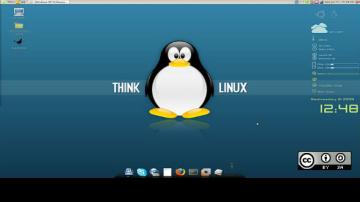I recently listened to an interesting interview on Linux for everyone. Host Jason Evangelho interviewed Christopher Scott, senior premier field engineer (open source) at Microsoft. Christopher is a Linux advocate who has a unique perspective as an avid Linux user who works for Microsoft. There was a time when there was little trust between Redmond and the Linux world. There are some who fear that Microsoft’s embrace of Linux is sinister. Christopher is trying to dispel that notion and build trust where mistrust has existed in the past. Listening to the interview invited my curiosity. Anxious to learn more, I contacted Christopher on Twitter and requested an interview (which has been lightly edited for length and clarity). He graciously agreed.
Don Watkins: What is your background?
Christopher Scott: In short, I’m a geek who loves technology, especially hardware. The first computer I got to spend any time with was our 486SX 20MHz 4MB RAM 171MB HDD IBM-compatible machine. My mom spent $2,500 on the setup at the time, which seemed outrageous. It wasn’t long after that I bought Comanche Maximum Overkill (PC Game) and realized I didn’t have a CD-ROM drive, nor a compatible sound card, so I bought those and installed them. That started it right there. I had to play games on our Windows 3.1 machine. That was really the focus of my interest in computers growing up: video games. I had the NES in 1984 and an SNES after, along with many other game systems since, but there was always something about PC gaming that caught my attention.
My first love, however, was cars. My dad was into hot rods and such, so I read his magazines growing up. I had high aspirations of building my own first car. After finding college to not be for me and realizing that minimum wage jobs wouldn’t secure my future, I went back to school and learned a trade: automotive paint and body repair. I got a job thanks to my instructor and did this for several years, but I wasn’t satisfied that most of the jobs were insurance claim-based. I wanted to focus on the attention to detail aspects and make every job come out perfectly, but insurance companies don’t pay for that type of detail with a "just good enough" mentality.
I wasn’t able to find work in a custom paint and body shop, so I looked to my second love, computers. I found a company that had training courses on Windows 2000 certification preparation. It was outrageously priced at something like $8,000, but I got a student loan (so I could carry that debt with me for many years after) and started class. I didn’t get a job immediately after, that took a number of months, but I worked my way into a temp job at Timex’s call center in the advanced products division.
I had been at Timex for a year-and-a-half or so when I was able to get a job offer at a "real computer company." It wasn’t temp work and it had benefits, so it seemed perfect. This company provided managed IT services for their customers, so I started doing PC and network support over the phone and in person. I met my wife while working for this company, too. Since then, I’ve done help desk support, litigation support, SharePoint, Skype for Business, Microsoft Teams, and all of the Office 365 Suite. Today I’m a happily married father of three with two grandsons.
DW: How did you get started with Linux and open source?
CS: Roughly 20 years ago, while I was taking classes on Windows 2000 Server, I started acquiring parts of older machines that were slated for disposal and managed to piece together at least one fully working system with a monitor, keyboard, and mouse. The home computer at the time was running Windows 98 or ME, I can’t recall, but I didn’t have any OS to put on this older system. Somehow, I stumbled across Mandrake Linux and loaded it up. It all seemed to work okay from what I could tell, so I put an ad in the local newspaper classifieds to see if anyone needed a computer for free. I got exactly one response to that ad. I packed up the computer and took it to their house. I found out it was a family with a special needs son and they wanted to get him learning on the computer. I set it up on the little table they wanted to use as a desk, they thanked me, and I left. I sure hope it was helpful for them. At the time, all I really knew of Linux was that I could have a fully working system without having to go to a store to buy a disk.
Since that point, I would consider myself a Linux hobbyist and enthusiast. I am a distro hopper, always trying out different distros and desktop environments, never making any one of them truly home. I’ve always had my heartstrings pulled between Ubuntu-based systems and Fedora. For some reason, I really like apt and DEB, but always loved getting faster updates from Fedora. I’ve always appreciated the way open source projects are open to the community for feedback and extra dev support, and how the code is freely available for anyone to use, reuse, and review.
Until recently, I wasn’t able to make Linux my primary OS. I’ve tried over the years and often it came back to games. They would either not run at all, or ran poorly by comparison, so I ended up returning to Windows. With the improvements to Proton and tools like Lutris, that landscape has changed dramatically. I run Linux on my primary desktop and laptop now. Currently, Pop!_OS and Ubuntu 18.04 respectively, but I do have a soft spot for Manjaro (which is on a third machine).
Admittedly, I do make concessions by having Linux as my primary OS for work. I mostly lean on web-based access to things I need, but I still have a VM for specific applications that won’t run outside of Windows and are required for my job. To be clear on this, I don’t hate Windows. I dislike some of the things it does and some of the things it doesn’t do. Linux, too, has things I like and dislike. My decision on what to run is based on what annoys me the least and what gives me the features and software I want or need. Some distros just don’t appeal to me or annoy me in a number of ways that I just cannot get over. Every OS has its pros and cons.
DW: What invited you to work for Microsoft?
CS: Short answer: A recruiter on LinkedIn. Long answer: Like many people who get into SharePoint, it fell into my lap a number of years ago. Okay, I volunteered, but no one else on the three-person IT team was going to learn it and our CEO wanted it. Fast forward about three years later, I got hired as a SharePoint admin for, what I thought, was a quite large company of 700 users. At that point, I considered Microsoft to be the top option to work for considering that’s who owns SharePoint, but I figured that I was five years or so away from being at the level I needed to be to even be considered. After working at this job for a year, I was contacted by a recruiter on LinkedIn. We chatted, I interviewed, and I got hired. Since then, I have jumped technologies to Skype/Teams and now open source software (OSS) and have gone from leading one team to over 20, all in sort of a non-traditional way.
To be more to the point, I wanted to move into an OSS role to see more of what Microsoft is doing in this space, which was something I couldn’t see in other roles while supporting other technologies.
DW: How are you building trust for the Linux community at Microsoft?
CS: The first step is to listen. I can’t assume to know, even though I consider myself part of the Linux community, what it would take to build that trust. So, I reached out to get that feedback. My goal is to take action against that feedback as merely an employee looking to make the software landscape better for Linux users who would appreciate the option of running Microsoft software on their chosen platform (as one example).
DW: What Microsoft products besides Visual Studio are wins for the Linux and open source community?
CS: Honestly, it depends on which part of the community you refer to. For developers, there are other things that were released/open-sourced by Microsoft that carry great benefits, like .NET and C++ libraries. Even Windows Subsystem for Linux (WSL) and the new Windows Terminal can be seen as big wins. However, there is another component of the community that wants something that impacts their daily, personal lives (if I were to summarize). In a sense, each individual has taken the stance to decide for themselves what constitutes a win and what doesn’t. That issue makes it more difficult at times when they request that Windows or the whole software catalog be open-sourced completely before even considering that Microsoft is doing anything valid.
Essentially, from how I view Microsoft’s standpoint, the company is focused on the cloud, namely Azure. Who in the Linux and open source community should be targeted that aligns with that? People who manage Linux servers, people who want to use open source software in Azure, and people who develop open source software that can run on Azure. To that market, there have been many wins. The catalog of OSS that runs in the context of Azure is huge.
DW: Some tech writers see the Linux kernel replacing the NT kernel. Do you disagree?
CS: I do disagree. There’s far too much incompatibility to just replace the underpinnings. It’s not realistic, in my opinion.
DW: What is the future of Linux at Microsoft?
CS: I’ll say what I expect and what I hope. I expect continued growth of Linux on Azure, and continued growth in open source used on Azure and written by Microsoft. I hope that this drives further investment into the Linux desktop, essentially, by bringing Windows software to run well on Linux. This topic is what the community wants to see, too, but it will take the customers, the individuals, within the enterprise speaking up to push this to reality.
Would I like to see, as an example, one code base for Office that runs on all desktop platforms whether through Wine or some other compatibility layer? Yes, of course. I think this would be optimal, really. Office for Mac has never seen all the same features as the Windows versions. Everyone should be empowered to use whatever software they wish, regardless of platform. I believe that Microsoft can get there, I just don’t know if it will, so that’s where I step in to do what I can to try to make this happen. I hope that we can see Linux desktop users have the same options for software from Microsoft as Windows and macOS.










Comments are closed.